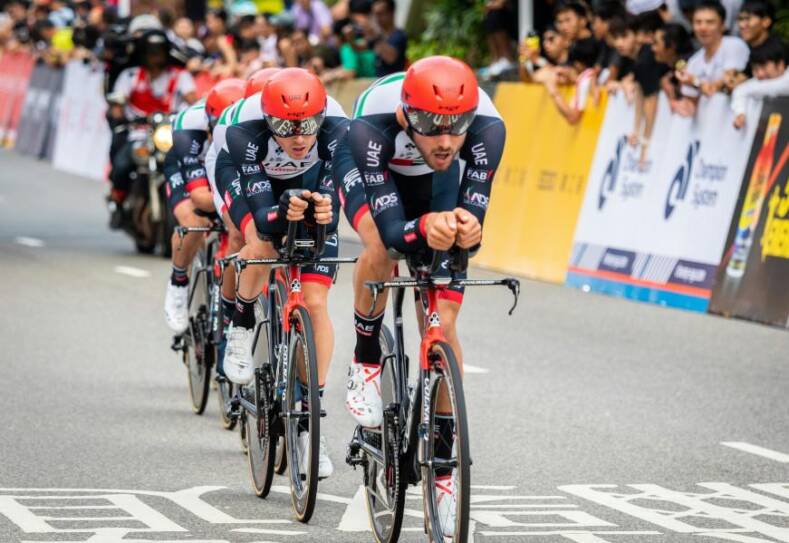Drafting is a critical technique in cycling, particularly in races or group rides. By closely following the rider in front, a cyclist can conserve energy by taking advantage of the reduced aerodynamic drag. The leader breaks the air ahead, creating a slipstream for following cyclists. The effectiveness of drafting is substantial; it can result in significant energy savings for the following riders, who can use up to 50 percent less effort than when cycling alone against the wind.
Cyclists employ drafting to maintain higher speeds without expending the energy they would if facing the full force of oncoming air. This strategy not only benefits those in the rear but can also be advantageous for the lead cyclist when taking turns at the front, allowing for shared energy expenditure amongst a group. It’s a skill that requires practice to master, especially considering the need for maintaining a close but safe distance behind the lead cyclist to maximize the benefits of reduced wind resistance.
While drafting, safety remains paramount, as the reduced distance between bikes leaves little room for error. Cyclists must develop trust and learn to read the movements of those in front to prevent collisions. This skill necessitates a steady and predictable riding style from all participants. Careful coordination and communication are often the keys to successful drafting, making it an essential aspect of group cycling dynamics.
Basics of Drafting
Drafting in cycling is a strategic technique used to improve efficiency by reducing wind resistance. Through this method, cyclists can conserve energy by optimizing their position relative to other riders and the wind.
Drafting Mechanics
Drafting occurs when a cyclist rides closely behind another, taking advantage of the reduced air pressure in the slipstream created by the lead rider. The following rider (“drafter”) experiences less air resistance and therefore requires less energy to maintain the same speed.
Aerodynamics in Cycling
Aerodynamics plays a crucial role in cycling performance. When a cyclist is in motion, air resistance acts against them like any other object. The shape and position of the rider, along with the bicycle’s design, can significantly affect the aerodynamics and ultimately the effort required to cut through the wind.
The Role of Wind Resistance
Wind resistance is the force exerted by the wind as a cyclist moves forward. It is the key factor that drafting seeks to overcome. By staying in the wake of the lead rider, the drafter has to overcome less wind resistance, resulting in energy savings which can be crucial during long races or rides.
Drafting Techniques and Formations
Drafting in cycling is a crucial skill that can save energy and improve speed, particularly in group rides and races. This section delves into the structured techniques and formations that cyclists use to optimize their performance through aerodynamic advantage.
Paceline Fundamentals
In a paceline, riders line up behind a leader closely, each benefiting from the reduced air resistance by following in the slipstream of the cyclist ahead. There are two main types:
- Single Paceline: Riders follow one after the other, taking turns at the front before peeling off to the back.
- Double Paceline: Two lines of cyclists alternate at the front, providing a steadier pace but requiring more coordination.
Key to an effective paceline is consistency in speed and distance. Riders should:
- Stay close to the wheel in front without overlapping.
- Take regular turns at the lead to share the workload.
- Signal when moving off the front to avoid sudden changes.
Echelon Formation
An echelon is a response to crosswinds, where riders position themselves diagonally across the road. This staggered formation allows each rider to still find shelter from the wind while adapting to its direction. Echelon formations require significant practice and awareness due to their complexity and the space they occupy on the road, making them more common in races than casual group rides.
The echelon’s key points are:
- Angle: Riders adjust their angle based on wind direction, maintaining partial cover from the rider ahead.
- Rotation: The echelon continuously rolls over so that no single rider takes the brunt of the wind for too long.
Slipstreaming Strategy
Slipstreaming, or drafting directly behind another rider, is a fundamental element of group riding and racing strategy. The rider in the slipstream conserves energy, sometimes up to 30%, by taking advantage of the lead rider’s break in the wind.
For effective slipstreaming, riders should:
- Maintain a short gap to the rider in front for maximal aerodynamic benefit.
- Communicate intentions and movements clearly to maintain group safety.
- Practice holding a steady line and avoiding sudden braking to prevent accidents.
These formations and strategies are essential for any competitive rider or peloton, as they conserve energy, improve efficiency, and can be decisive in the outcomes of races. Each requires discipline and coordination and is best honed through regular practice on group rides.
Equipment and Gear
In the sphere of cycling, particularly when drafting, selecting the right equipment can vastly improve performance. The gear includes not only the bike but also appropriate clothing and the use of modern technology such as power meters and cadence sensors.
Choosing the Right Bike
When it comes to performance in drafting, the cyclist’s choice of bike is crucial. Aerodynamic designs are paramount, with features like bladed spokes, deep-section rims, and frames that minimize wind resistance. The bike’s geometry should also be considered, as a more aggressive position can reduce the rider’s frontal area and therefore drag. Models specifically designed for racing often provide the best benefits for drafting.
- Examples of aerodynamic bikes:
- Specialized Venge
- Trek Madone
- Canyon Aeroad
Aerodynamic Clothing Options
The cyclist’s apparel can have a surprisingly significant impact on aerodynamics. Tight-fitting jerseys and shorts reduce the air resistance, as do skinsuits for time trials and races. Materials matter as well; fabrics engineered for low drag can shave off critical seconds.
- Key clothing features:
- Seamless design
- Textured fabrics that disturb airflow
- Skin-tight fit
Technology in Drafting: Power Meters and Cadence Sensors
Advanced technology allows cyclists to fine-tune their drafting strategy. Power meters provide real-time data on energy output, allowing riders to maintain optimal effort levels while drafting. Meanwhile, cadence sensors monitor pedaling rate, helping to keep the cyclist in the most efficient gear when in a slipstream. Both devices play a pivotal role in maximizing drafting efficiency.
- Benefits of using technology:
- Improved pacing
- Enhanced energy conservation
- Data for post-ride analysis
By integrating the right bike, aerodynamic clothing, and up-to-date technology, cyclists can gain a tangible advantage when drafting.
Racing and Group Rides
Cycling races and group rides encompass a range of dynamics, from the cooperative drafting techniques within a peloton to strategies critical for success in competitive races.
Group Ride Dynamics
Group rides function on the principle of collective effort, where cyclists ride in close proximity to reduce air resistance and conserve energy. Pacelines—single or double-file formations—are integral, with the front rider breaking the wind for those behind. Large group rides or pelotons display complex movement, with riders consistently rotating to share the workload. Riders should remain alert, with hands covering brakes to respond to sudden changes.
Bike Race Strategies
In races, drafting is a tactical maneuver. Breakaways are a strategy where one or a group of riders accelerates away from the peloton to avoid challenges like sprint finishes. However, it requires immense effort without the wind-blocking advantage. Races often hinge on knowing when to lead and when to tuck in behind another rider to preserve energy for critical moments.
Peloton Positioning and Movement
Within a peloton, positioning is vital for conserving energy and staying safe. Riders at the outer edges face more wind, while those at the center enjoy greater protection. In grand tours, like the Tour de France, peloton behavior is particularly significant during mountain stages or windy conditions, where positioning can make the difference between staying in contention or losing critical time.
Safety and Communication
In group cycling, safety is paramount and hinges largely on clear communication and understanding of body language among riders.
Maintaining Safety During Group Rides
Safety during group rides requires that all participants stay alert to their environment and to the movements of other cyclists. The leader of a paceline is responsible for breaking the wind, but they also need to be the eyes of the riders behind, signaling any obstacles or changes in pace. Meanwhile, following riders should maintain a safe distance that allows enough reaction time.
- Key Safety Practices:
- Stay vigilant for road hazards.
- Cover your brakes at all times for quick stopping.
- Consistently check for signals from the rider in front.
Effective Communication Among Riders
Clear communication in a cycling group involves both verbal cues and hand signals. Essential in maintaining group coherence, these signals convey intentions and alert riders to potential dangers or changes in the environment.
- Communication Tools:
- Verbal Cues: Shouts such as “Slowing!” or “Turning left!”
- Hand Signals: Pointing at hazards, waving to indicate a slow down, or patting the back to signal stopping.
Each group may develop their own specific cues, but universal gestures are generally accepted and understood by all cyclists.
Understanding Body Language
Body language serves as a silent but powerful form of communication. A rider’s posture can indicate fatigue, alertness, or preparation for a maneuver. Those riding behind should observe the leading rider’s body language to anticipate changes and react appropriately.
- Body Language Indicators:
- Positioning: Ready to sprint or relax.
- Head Movements: Checking blind spots or signaling a turn.
- Arm Extensions: Pointing out obstacles or directing the group.
A keen understanding of body language complements verbal communication, ensuring a safer ride for everyone involved.
Advanced Drafting Techniques
In mastering advanced drafting techniques in cycling, riders optimize their performance by managing crosswinds, executing coordinated breakaways, and developing energy conservation strategies to maximize the benefits of riding in a peloton.
Managing Crosswinds
When riding in crosswinds, cyclists must adjust their position to maintain an aerodynamic advantage. They should orient themselves in an echelon formation, where each rider is slightly downwind from the one ahead. This format reduces the surface area exposed to the crosswind, allowing riders to use less energy while maintaining speed.
- Echelon Formation:
- Leader: Directly into the wind.
- Followers: Staggered downwind.
Coordinated Breakaways
A breakaway refers to a rider or a group of riders who have pulled away from the main peloton. Executing a successful breakaway demands coordinated efforts among riders. They must communicate effectively and share the workload of cutting through the air at the front. Riders take turns in the lead position before rotating off to draft and recover.
- Breakaway Coordination:
- Take Lead: Rider at the front pulls.
- Rotate: Lead rider moves aside after a determined period.
- Draft: Recover in the slipstream of fellow breakaway riders.
Energy Conservation Strategies
Energy conservation is crucial for endurance in cycling. Riders should remain relaxed and maintain a steady cadence behind the lead rider to conserve energy. When it is their turn to lead, they should do so smoothly without surging to maintain group momentum and minimize energy spikes.
- Conservation Techniques:
- Relaxed Posture: Minimize muscle tension.
- Steady Cadence: Avoid unnecessary acceleration.
- Smooth Transitions: Lead without surging.
Training and Fitness
Cycling proficiency relies on well-structured training and monitoring fitness to efficiently utilize drafting techniques. Riders should focus on developing endurance, honing drafting skills through targeted practice, and employing technology to track performance.
Building Stamina for Long Rides
Cyclists can increase their stamina by consistently engaging in long-distance rides, gradually extending the duration and intensity. Proper endurance training should include:
- Weekly Long Rides: Incrementally add miles each week to a long ride at a moderate intensity.
- Interval Training: Intervals of high-intensity efforts followed by rest periods to boost cardiovascular fitness.
Adhering to these methods helps a rider withstand the rigors of long rides while effectively leveraging the benefits of drafting by staying relaxed and maintaining close proximity in a group ride without fatiguing prematurely.
Drafting Practice Regimens
To master drafting, one must practice within a group setting to understand the dynamics of wind resistance and energy conservation.
- Structured Group Rides: Joining regular group rides to simulate race conditions.
- Rotational Drills: Conducting drills to practice taking turns at the front and falling back into the slipstream.
These exercises assist in learning how to position oneself to optimize the reduction of wind resistance and engage effectively in a peloton.
Fitness Tracking and Performance Metrics
Athletes can track their fitness and adjust their training using quantitative data from devices like power meters.
- Power Meters: These devices gauge a rider’s power output, allowing for precise training at different intensity levels.
- Performance Metrics: Key metrics include heart rate, speed, and cadence, which can be monitored to tailor a fitness plan.
By analyzing this data, cyclists can make informed decisions about their training regimens, ensuring continual improvement in both individual fitness and group riding efficiency.
Environmental Factors and Considerations
The performance of cyclists, particularly when drafting, is influenced by environmental factors like weather and course topography, each playing a critical role in racing strategies.
Drafting in Different Weather Conditions
Rain significantly affects drafting efficiency. It increases road friction and reduces visibility. Riders must balance the aerodynamic advantage of drafting with safety concerns, as wet conditions can cause slippery surfaces. It’s crucial for a rider to maintain an increased following distance to allow more reaction time. Additionally, drag from rain can prompt a rider to stay closer in the air pocket behind another to maintain speed with less effort.
Wind conditions can drastically change drafting dynamics. A headwind increases the importance of drafting, as the lead rider bears the brunt of the wind resistance. Sidewinds present a unique challenge, requiring cyclists to stagger their formation to create effective slipstreams. In strong crosswinds, a rider must be attentive to stay within the protective air pocket that can shift with the wind’s direction.
Adapting to Race Course Topography
The race course topography significantly influences drafting strategies. On flat terrain, maintaining a close distance behind the front rider is ideal for conserving energy due to reduced drag. Cyclists can often stay within an optimal draft zone of 10 to 30 centimeters to maximize the draft benefit.
Climbs and descents require different approaches to drafting. Uphill sections reduce the impact of aerodynamics since speeds are slower and drag is less of a factor. However, the rider can still benefit from drafting by using the lead rider as a pacer. On downhill and flat sections where speeds are higher, the air pocket created by the lead rider is more beneficial, and precise positioning becomes crucial for riding efficiently.
Cultural Impact of Drafting
Drafting, a strategic element utilized in cycling, has shaped both the competitive tactics and the iconic moments within the sport. Its influence is most evident in professional races and has been pivotal in crowning champions.
Drafting in Professional Cycling
In the world of professional cycling, drafting is a fundamental skill that riders must master. It allows them to conserve energy by reducing air resistance, which can be critical during long stages. This technique has had a significant cultural impact, as it fosters a sense of teamwork even in an individual sport. Cyclists within a team collaborate, taking turns at the front, thus sharing the burden of wind resistance. The ‘domestiques’ work to protect their leader, contributing to the strategic prowess for which cycling teams are known.
Tour de France, cycling’s most prestigious event, showcases drafting’s significance. Teams meticulously plan their strategies, considering when to draft and when to attack. The winners often credit their victories to effective drafting, which helped them conserve energy for crucial moments.
Iconic Races and Moments
Drafting has led to some of the most unforgettable races and moments in cycling history. One such race is the Tour de France, where crosswinds and strategies around drafting can make or break a rider’s chance for the yellow jersey.
- King of the Mountain (KOM): While drafting is less impactful in the mountain stages, it still plays a part in the fight for the KOM title.
- Champs-Élysées: Drafting becomes critical in the final sprint on the Champs-Élysées, a defining moment where racers line up behind their sprinter, who drafts until launching for the finish line.
Throughout these sections of the race, cyclists’ skills in drafting help carve their names into the annals of history. Champions often emerge by utilizing drafting as a key component of their race-winning strategies.








